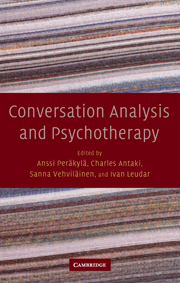Book contents
- Frontmatter
- Contents
- List of illustrations
- List of contributors
- Foreword: Filling the gaps
- 1 Analysing psychotherapy in practice
- 2 Formulations in psychotherapy
- 3 Clients' responses to therapists' reinterpretations
- 4 Lexical substitution as a therapeutic resource
- 5 Resisting optimistic questions in narrative and solution-focused therapies
- 6 Conversation analysis and psychoanalysis: Interpretation, affect, and intersubjectivity
- 7 Identifying and managing resistance in psychoanalytic interaction
- 8 Person reference as a device for constructing experiences as typical in group therapy
- 9 Conversation of emotions: On turning play into psychoanalytic psychotherapy
- 10 A psychotherapist's view of conversation analysis
- 11 A review of conversational practices in psychotherapy
- Transcription notation
- References
- Author index
- Subject index
6 - Conversation analysis and psychoanalysis: Interpretation, affect, and intersubjectivity
Published online by Cambridge University Press: 22 September 2009
- Frontmatter
- Contents
- List of illustrations
- List of contributors
- Foreword: Filling the gaps
- 1 Analysing psychotherapy in practice
- 2 Formulations in psychotherapy
- 3 Clients' responses to therapists' reinterpretations
- 4 Lexical substitution as a therapeutic resource
- 5 Resisting optimistic questions in narrative and solution-focused therapies
- 6 Conversation analysis and psychoanalysis: Interpretation, affect, and intersubjectivity
- 7 Identifying and managing resistance in psychoanalytic interaction
- 8 Person reference as a device for constructing experiences as typical in group therapy
- 9 Conversation of emotions: On turning play into psychoanalytic psychotherapy
- 10 A psychotherapist's view of conversation analysis
- 11 A review of conversational practices in psychotherapy
- Transcription notation
- References
- Author index
- Subject index
Summary
In this chapter, I will use conversation analysis to explore some themes that are central in the clinical theory and practice of psychoanalysis. These themes include interpretation (which is a central theme in classical psychoanalytic theory), and affect and intersubjectivity (which are central themes in some contemporary psychoanalytic discussions). I will discuss these themes using two kinds of empirical material: clinical notes arising from my own psychoanalytic practice, and transcribed materials coming from a corpus of fifty-eight tape recorded psychoanalytic sessions collected by Sanna Vehviläinen and myself. Clinical notes involve the traditional method of representing interaction in psychoanalysis. The aim of the chapter is to show how the conversation analysis of tape recorded material can radically expand our understanding of the key practices of psychoanalysis.
In theoretical and methodological terms, this chapter draws upon the idea of “professional stocks of interactional knowledge” (SIKs). We (Peräkylä & Vehviläinen, 2003) have proposed that professions dealing with clients have their specific stocks of knowledge which describe and prescribe the professional interactions. We suggested that conversation analysis should enter into dialogue with such SIKs; this chapter is one effort towards such a dialogue (see also Forrester & Reason, 2006).
I should acknowledge my specific position in relation to psychoanalysis and conversation analysis. For nearly twenty years, I have been involved in doing conversation analytic research on therapeutic and medical encounters. Since 2003, I have been involved in psychoanalytic training organized by The Finnish Psychoanalytic Association.
- Type
- Chapter
- Information
- Conversation Analysis and Psychotherapy , pp. 100 - 119Publisher: Cambridge University PressPrint publication year: 2008
- 33
- Cited by

